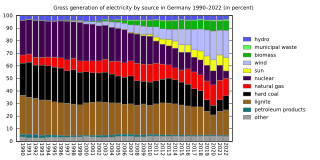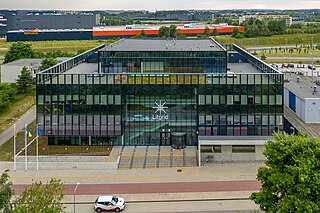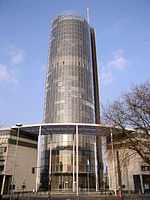
Electric power transmission is the bulk movement of electrical energy from a generating site, such as a power plant, to an electrical substation. The interconnected lines that facilitate this movement form a transmission network. This is distinct from the local wiring between high-voltage substations and customers, which is typically referred to as electric power distribution. The combined transmission and distribution network is part of electricity delivery, known as the electrical grid.

Electric power distribution is the final stage in the delivery of electricity. Electricity is carried from the transmission system to individual consumers. Distribution substations connect to the transmission system and lower the transmission voltage to medium voltage ranging between 2 kV and 33 kV with the use of transformers. Primary distribution lines carry this medium voltage power to distribution transformers located near the customer's premises. Distribution transformers again lower the voltage to the utilization voltage used by lighting, industrial equipment and household appliances. Often several customers are supplied from one transformer through secondary distribution lines. Commercial and residential customers are connected to the secondary distribution lines through service drops. Customers demanding a much larger amount of power may be connected directly to the primary distribution level or the subtransmission level.
Transpower New Zealand Limited (TPNZ) is the state-owned enterprise responsible for electric power transmission in New Zealand. It performs two major functions in the New Zealand electricity market. As the owner of the National Grid it provides the infrastructure of electric power transmission that allows consumers to have access to generation from a wide range of sources, and enables competition in the wholesale electricity market; as system operator it manages the real-time operation of the grid and the physical operation of the electricity market.

The National Grid is the high-voltage electric power transmission network serving Great Britain, connecting power stations and major substations, and ensuring that electricity generated anywhere on the grid can be used to satisfy demand elsewhere. The network serves the majority of Great Britain and some of the surrounding islands. It does not cover Northern Ireland, which is part of the Irish single electricity market.
RWE AG is a German multinational energy company headquartered in Essen. It generates and trades electricity in the Asia-Pacific region, Europe and the United States. The company is the world's second-largest offshore wind power generation and Europe's third-largest company in renewable energy. In the 2020 Forbes Global 2000, the RWE Group was ranked as the 297th-largest public company in the world.
Statnett is a Norwegian state owned enterprise responsible for owning, operating and constructing the stem power grid in Norway. The company has its headquarters in Oslo, Norway.
Elektro-Slovenija, d.o.o. (ELES) is a state-owned electricity transmission company of Slovenia. The company was founded in 1991 by the Government of Slovenia. It is the only power transmission system operator in the country. ELES operates the network of 400 kV, 220 kV and 110 kV transmission lines with a total length of 2,587 km (1,607 mi). The managing director of the company is Aleksander Mervar.
Verbund AG, formerly known as Verbundgesellschaft or Österreichische Elektrizitätswirtschafts-AG, is Austria's largest electricity provider. Verbund covers around 40 percent of electricity demands in Austria and generates 90 percent thereof from hydro power. In addition, Verbund operates the supraregional power grid through its subsidiary APG. Verbund AG is listed on the Vienna Stock Exchange and in the ATX, the key index of Austrian stock-listed companies. The largest shareholder, at 51%, is the Republic of Austria.
TenneT is a transmission system operator in the Netherlands and in a large part of Germany.
Energinet is the Danish national transmission system operator for electricity and natural gas. It is an independent public enterprise owned by the Danish state under the Ministry of Climate and Energy. Energinet has some 1150 employees, and its headquarters are located in Erritsø near Fredericia in Jutland. The gas division is located in Ballerup near Copenhagen.
Terna S.p.A. is a transmission system operator (TSO) based in Rome, Italy. It operates through Terna Rete Italia, that manages the Italian transmission grid and Terna Plus which is in charge of new business opportunities and non-traditional activities in Brazil, Chile, Peru and USA (2022). With 74,910 kilometres (46,550 mi) of power lines or around 98% of the Italian high-voltage power transmission grid, Terna is the sixth largest electricity transmission grid operator in the world based on the size of its electrical grid. Terna is listed on the Borsa Italiana and is a constituent of the FTSE MIB index.
The electricity sectors of the Republic of Ireland and Northern Ireland are integrated and supply 2.5 million customers from a combination of coal, peat, natural gas, wind and hydropower. In 2022, 34 TWh were generated. In 2018 natural gas produced 51.8%, while wind turbines generated 28.1%, coal 7%, and peat 6.8% of Ireland's average electricity demand. In 2020 wind turbines generated 36.3% of Ireland's electrical demand, one of the highest wind power proportions in the world. While the United Kingdom was one of the first countries in the world to deploy commercial nuclear power plants, the island of Ireland has never had a nuclear power plant built on either side of the Irish border. Nuclear power in Ireland was discussed in the 1960s and 1970s but ultimately never phased in, with legislation now in place explicitly forbidding its introduction.

HVDC BorWin1 is the first HVDC facility in the world to be built for importing power from an offshore wind park to shore, and the first to use voltage source converters (VSC) in Germany. It connects the offshore wind park BARD Offshore 1 and other offshore wind farms in Germany near Borkum to the European power grid. The facility was built by ABB and has a capacity of 400 MW at a bipolar voltage of ±150 kV. HVDC BorWin1, which leads from BorWin Alpha Offshore Platform to Diele substation, consists of a 75 kilometres (47 mi) of underground and 125 kilometres (78 mi) of submarine cable.
Elia is a Belgian transmission system operator for high-voltage electricity, located in Brussels, Belgium. It operates in Belgium and Germany. The company transmits electricity from generators to distribution system operators, which then supply SMEs and homes. Elia also has contracts with major industrial users that directly connect to its high-voltage grid.

50Hertz Transmission GmbH, formerly named Vattenfall Europe Transmission, is one of four transmission system operators for electricity in Germany, and is wholly owned by Eurogrid GmbH, indirectly owned and managed by the Belgian transmission system operator Elia System Operator and Australian-based IFM Investors. The company is a member of the European Network of Transmission System Operators for Electricity (ENTSO-E).

Germany's electrical grid is part of the Synchronous grid of Continental Europe. In 2020, due to COVID-19 conditions and strong winds, Germany produced 484 TW⋅h of electricity of which over 50% was from renewable energy sources, 24% from coal, and 12% from natural gas. This is the first year renewables represented more than 50% of the total electricity production and a major change from 2018, when a full 38% was from coal, only 40% was from renewable energy sources, and 8% was from natural gas.

Litgrid AB is a Lithuanian electricity transmission system operator that operates Lithuania's electricity transmission grid. Litgrid is responsible for the integration of the Lithuanian electricity system into the European electricity infrastructure and the common electricity market.
CAO Central Allocation Office GmbH was the joint auction office allocating cross border electricity transmission capacity for borders between Austria, Czech Republic, Germany, Hungary, Poland, Slovakia and Slovenia. CAO acted as commission agent of owners of transmission networks.
Swissgrid, based in Aarau and Prilly, is the Swiss transmission grid operator. It is subject to supervision by the Swiss Federal Electricity Commission ElCom.
Still in the stage of development, local flexibility markets for electricity will enable distributed energy resources to provide their flexibility in electricity demand or production/feed-in for the system operator or another counterparty at a local level. As there are different purposes for the use of this flexibility, there exist a variety of different market designs, comprising different actors and role models. Several local market models aim to efficiently tackle the widespread issue of grid congestion and fairness.









